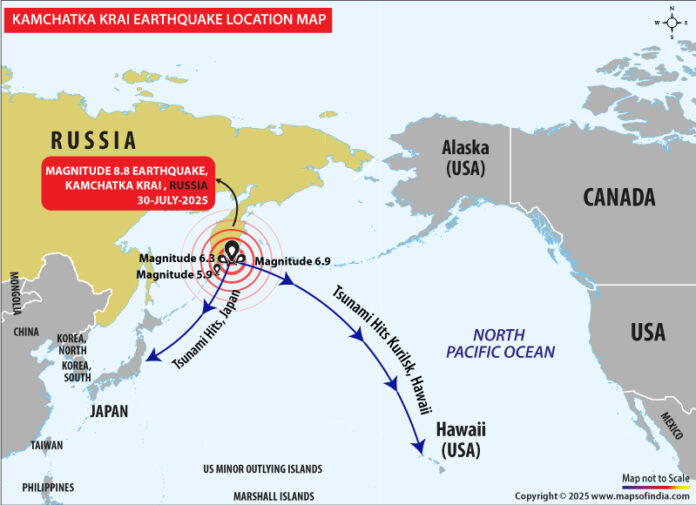A massive 8.8-magnitude earthquake rocked Russia in a formidable display of the power of nature as the Kamchatka Peninsula became a victim of the earthquake, which sent its tremors around the Pacific Rim and even around the Russian Far East. This earthquake has caused a tsunami that has already reached various coastal sites such as Kurilsk, Kamchatka parts and even sites as far as the Numero alarming citizens and governments in various countries.
The Earth Trembles: The Quake Strikes Kamchatka
It was a tremor early in the morning, local time and the epicenter area where it took place was under the seafloor close to the eastern coast of Kamchatka. As the Russian Geophysical Service has reported, the quake measured 8.8 on the Richter scale, and it was one of the strongest ones in recent memory that struck the region. At Magadan and even in northern Japan, tectonic tremors were felt initially, followed by state-level automatic alerts due to governments initiating emergency activities.
A powerful series of earthquakes rattled the region near Yuzhno-Sakhalinsk, Russia in quick succession. The seismic activity began at 5:39 AM with a magnitude 6.9 quake striking 1,371 km from the Yuzhno – Sakhalinsk, Russia. Just seven minutes later, at 5:46 AM, another tremor measuring 6.3 on the Richter scale hit 1,343 km away from Yuzhno-Sakhalinsk, Russia. This was followed by a magnitude 8.8 megaquake, the strongest in the sequence, striking 1,393 km from Yuzhno-Sakhalinsk at 6:57 AM. Later, at 8:00 AM, a fourth quake measuring 5.9 struck 1,156 km from the same location. The clustered timing and escalating intensity of these quakes have raised serious concerns across the region.
Residents of Kamchatka reported frightening scenes: windows shook, furniture fell, and large areas lost power. Tenants were running out of buildings, and emergency services were advising people to evacuate the low-lying areas as soon as they could.
Tsunami Waves Follow
Soon after the earthquake, warnings against tsunamis were made in the Pacific region. In a few hours, tsunami waves, some of them up to 1.5 meters, hit Kurilsk coastal regions, destroying infrastructure and flooding sections of the town. During this flood in Kamchatka itself, several fishing villages along the eastern coastline even reported water rushes overcoming boats, docks, and some residential constructions.
The tsunami did not only happen on the coast of Russia. The waves swept along the Pacific Ocean at a very fast rate, arriving as far as Numero, a remote coastal region that is prone to such natural catastrophes. The protective tsunami coastlines of Alaska, Hawaii, Chile and the Solomon Islands were deployed because the tsunami fanned out. Some of these areas did not have severe surges, except that the psychological effects and precautionary evacuations were high.
Widespread Alert and International Response
Tsunami warning systems were put into full operation as the seismic waves reverberated all over the world. In Japan, officials gave warnings to the north-facing areas such as Hokkaido. Emergency services in Alaska put coastal towns on high alert, and Hawaiian beaches witnessed a score of evacuations along the southern region.
In Chile, where a nation knows all too well the seismic activity of the Pacific, emergency management organs put coastal evacuation procedures into play, expecting the possibility of waves striking the area. In the meantime, New Zealand on the east coast of the northern island has given a warning of a threat to the marine environment, requesting the inhabitants to relocate to uplifted land.
Pacific Tsunami Warning Centre (PTWC) in Hawaii observed wave activity and synchronized the information with other agencies in the region in real-time. This is the typical scenario of how far-reaching the consequences of them can extend over ocean basins. The magnitude and the depth of this earthquake have produced enough energy that can seriously affect a large geographical radius.
Impact on Daily Life and Infrastructure
Life has stagnated in Kamchatka and Kurilsk. There is an ongoing closure of schools, offices, and massive interference in transportation. The ports locally are closed because of the water damage and security reasons, especially to the small fishing communities, as they rely on the sea.
There are schools, churches, and community centres that have opened up emergency shelters. Families that are displaced are receiving food, water, and blankets being distributed by relief teams. Telephone and electricity are slowly coming back, although most of the rural places remain unlit.
Roads have incurred damage, and some houses located near the seashore were washed away in Numero, another unpopular but equally hit area. No deaths have been confirmed yet, but dozens of people were injured and a few are still missing. Rescue efforts are already going on, and the local volunteers and army are working day and night.
Preparedness and Future Measures
In view of such an incident, the need highlighted is that of disaster preparedness and in particular in disaster-prone areas such as those around the Pacific Ring of Fire. Kamchatka is located on the fringe of this unstable territory and is not new when it comes to earthquakes or volcanic activity.
Analysts point out that although the early-warning mechanisms and quick response reduced the number of casualties suffered in the region, the size of the earthquake and the tsunami requires long-lasting solutions. These are enhanced resilience of infrastructure, increased awareness of evacuation strategies by the people and enhanced cooperation of countries in the early warning systems.
The President of Russia, Vladimir Putin, has spoken out on the matter and directed federal assistance to the region. His depiction of the safety and rehabilitation of our citizens in Kamchatka and Kurilsk is our chief priority, he added in an emergency briefing. Medical aid and materials, such as materials for reconstruction, and humanitarian teams in neighbouring areas are already coming.
A Stark Reminder
Such an event is a harsh reminder that this planet can be wild and unpredictable. The endurance and strength of the physical infrastructure are assessed in such incidents, but also the people who suffered because of the earthquake.
At the moment, people of Kamchatka, Kurilsk and Numero are still in a state of shock, reeling, cleaning up and rebuilding what is left behind. The wrath of nature might not be avertable, but human cooperation, science, and resilience will remain our best suit in case of these tragedies.




